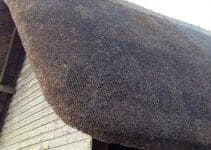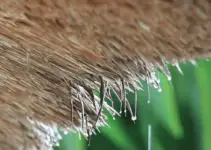Thatched roofs might be seen as quaint cottage features in rural, traditional areas, but they were once a ubiquitous roofing material. Thatched roofs were (and still are) used across the world by all different cultures.
While this might imply some kind of ancient connection, putting reeds on top of a building is a fairly standard idea.
But when were thatched roofs invented, and by whom? Let’s look at the history of thatched roofing to see if we can find out.
When Were Thatched Roofs Invented? Unfortunately, there’s absolutely no way to tell when thatched roofs were invented. However, based on the technology (or lack thereof) needed to build a thatched roof, it’s fair to assume that they’ve existed for as long as humans have built shelters.
Humans began farming around 12,000 years ago. If you look at the modern materials used for thatched roofs (reeds and straw), it’s again fair to assume that these ancient people used grass and leftover farming materials to build rudimentary shelters.
Oldest Thatched Roof
Determining the oldest ever thatched roof is challenging due to the organic nature of the materials used, which are prone to decay and do not preserve well over time. However, evidence of thatching dates back to the Neolithic period, around 6700 BC, as seen in the remains of a settlement at Çatalhöyük in modern-day Turkey.
One of the earliest examples we have in the UK (and, indeed, the world) of a thatched building is Howick House in England. It’s believed to have been built around 7,800BC, and there is evidence that its roof used turf and reed thatch.
This puts it very firmly in the Mesolithic era, although it’s certainly possible that people were thatching buildings before then. As you can imagine, finding archaeological evidence of things like reed and straw is pretty difficult.
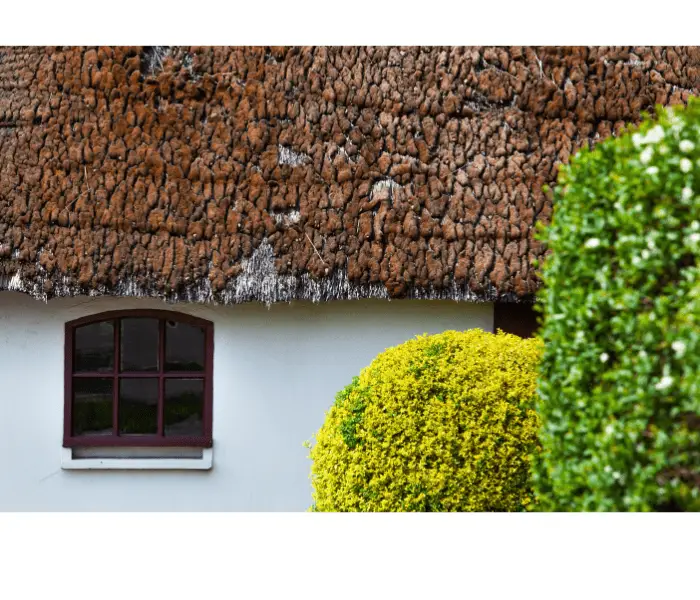
The Continued History of Thatched Roofs
Jumping forward a few thousand years, we land in the European Iron Age. Thatch was essentially the only roofing material during this era, although some cultures used sod (turf) for their roofs as well.
Sod was common in colder areas, such as Denmark, Iceland, Sweden, etc., as it was good at keeping the warmth in.
Iron Age people built roundhouses out of wattle and daub (basically sticks and mud) with conical roofs. The thatching material would vary depending on what they had on hand. Typically, it would be water reeds or straw. Roundhouses varied massively in size, but their roofs could have a diameter of up to 15m!
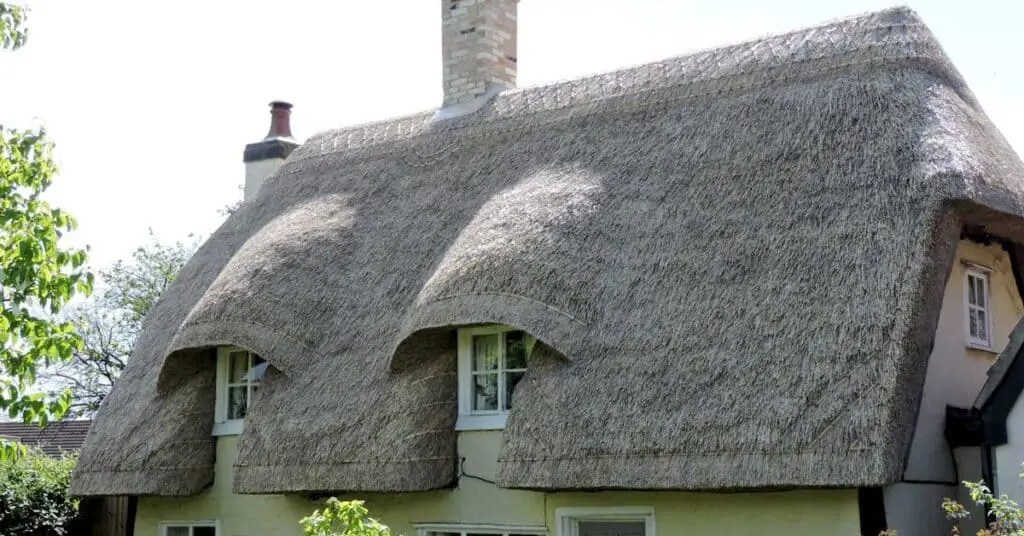
There wasn’t much significant change in thatched roofs for a good thousand years after the Iron Age. While the buildings changed shape, the basic construction materials stayed the same.
The Romans popularised tile roofs, but only on important buildings. Thatch was still a common material for them, as evidenced by coins from the reign of Emperor Constans (4th century).
Anglo Saxons in England continued to use much of the basic Iron Age design, although they moved towards rectangular buildings.
Some of their buildings were massive – there’s evidence of some being more than 23 x 79m. These would also have thatched roofs, which, as you can imagine, were also huge.
In the Middle Ages, thatching was a worthy profession. After all, people needed roofs on their homes! At this point in history, rectangular buildings had become the norm, and it was common for roofs to almost reach the ground.
It helped provide insulation for what would otherwise be a pretty cold home.
Thatch was even used on castles, both during and after construction. While many of the main buildings would have tile roofs, less important or wealthy areas would use thatch.
As castles took many years to build, thatchers would cover the half-built walls with reeds or straw in the winter to protect them from the weather.
It was in the Tudor period that thatched roofs started to die off. You’d still see them on poorer buildings, but the wealthy switched to fancier materials, such as tiles.
Among other things, the Tudors popularised bricks for construction, which meant buildings could be taller and could bear more weight. In turn, this meant second stories on their homes and heavier, more permanent roofs.
But at the same time, better building techniques meant even thatched roofs could last longer and look better. Many of the remaining examples we have of old thatched buildings come from this period or slightly later, showing just how good construction methods had become.
The industrial revolution dealt several more blows to thatched roofs. First, industrialisation meant roof tiles could be produced on much larger scales, making them more widely available.
Second, networks of canals and railways meant it was easier to transport heavy materials to more remote locations.
And finally, changes in agriculture meant straw wasn’t as widely available. This was in part due to the invention of the combine harvester, which meant less straw made it through the harvesting process.
Also, people began breeding short-stemmed wheat varieties and using fertilizer, meaning any straw that did survive was shorter and of worse quality.
So, by the 1800s, thatched roofs had become something of a novelty. As with many other modern ideas, this is when our current perception of thatched roofs began.
They were more closely associated with quaint rural villages and were seen as exceptions rather than the norm.
It wasn’t until the late 20th century that thatched roofs took off again. While it’s still not a popular material for new builds, there’s a growing market of people looking specifically for thatched roof properties. Luckily, this means, if nothing else, that we’re able to keep this ancient tradition alive.
Who Invented the Thatched Roof?
As you can probably guess, there is absolutely no way to say who invented the thatched roof. It’s like asking who invented the bow and arrow or farming.
The concept dates back well beyond the start of recorded history and is common across different cultures that likely had no connections to one another.
Thatched roofs are one of those things where the idea is, in essence, so basic that it just kind of happened. There’s evidence of thatched roofs used in the Neolithic period in Europe, but also in Incan and Mayan civilisations from the other side of the world.
The easier question to answer is why thatched roofs – simply because the materials existed and it was a logical move for better protection.
Thatched Roofs Around the World
So far, we’ve mainly focused on European (specifically British) thatched roofs, as the country has a long and clear history of this building material. However, as mentioned, thatched roofs are common across the world, although the materials and techniques vary.
Let’s take a look at some other examples of thatched roofs.
Europe
Despite discussing Europe already, there are some examples still worth mentioning. Normandy, in northern France, has some amazing examples of thatching techniques. They plant irises on the roof, as the roots draw up excess moisture and help hold the material together.
Also, in the late-18th century, French nobility went through a phase of building model villages so they could play at farming. Unsurprisingly, thatched roofs were common, but it allowed architects to play with different styles while also developing the concept of thatching.
Central and Southern America
The Maya, Incas and Aztecs were all big on thatched buildings. As in Europe, the materials were common by-products of farming, but obviously living in and near rainforests meant access to all kinds of amazing thatching materials.
It’s believed that Machu Picchu had thatched roofs on its stone buildings. They even used special stones lodged in the walls to tie the roof down. Doing so protected it from strong winds and harsh weather. According to one account from a Spanish conquistador, the roofs could sometimes be 2m thick!
USA and Canada
Native Americans used thatch on their homes long before Europeans came to America. Of course, we have very little evidence of the materials they used or the styles they built in.
Unsurprisingly, the European settlers brought their thatching techniques with them to North America. American homes typically don’t have a set style; they’re instead a mix of historical European designs. Thatch is still common on some more rural properties, even new builds, thanks to its connection with the “old world”.
Asia
Japan has a massive thatched roof industry, particularly for its Shinto temples. Some of these buildings have existed for at least a thousand years, although they’re rebuilt several times a century. Thatch is also used on Minka, which translates to “houses of the people”. They’re small, traditional homes that use all kinds of roof materials.
Elsewhere, in Bali, temple roofs are traditionally made from ijuk. The fibres are black and come from Arenga pinnata, which is a type of feather palm. Black thatched roofs on temples are particularly striking, particularly as the roofs are tiered.
A temple can have anywhere from 3 to 11 tiers on its roof!
Check out our blog on thatched roofs in Australia.
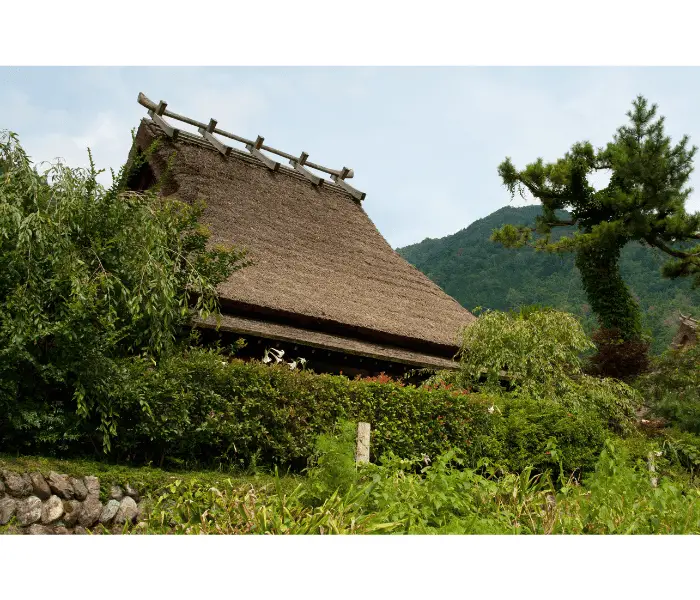
Africa
Thatch roofing in Africa has a rich history dating back thousands of years. Thatching was widely used across the continent due to the abundance of locally available materials such as grass, palm leaves, and reeds.
These materials were both sustainable and eco-friendly, as they were easily harvested and replaced with minimal impact on the environment.
The design and techniques of thatch roofing varied among African cultures, with each group adapting to the specific needs of their region.
For instance, in the arid Sahel region, the Fulani people constructed conical thatched roofs, while in the humid tropical areas of West Africa, the Akan people built thatched roofs with steep pitches to ensure effective rainwater drainage.
Throughout history, thatch roofing in Africa has demonstrated remarkable resilience, even in the face of external influences.
Thatch roofing remains an integral part of African architecture, particularly in rural areas where it continues to be the preferred choice. Not only because of its cultural significance but for its affordability, insulation and functional properties.
In recent years, there has been a resurgence of interest in traditional thatched roofing techniques as a means of preserving cultural heritage and promoting sustainable building practices.
This has led to the development of innovative solutions, such as improved fire-resistant treatments and hybrid designs that combine traditional thatch with modern materials, ensuring the continued relevance of this ancient African craft.
Old-World Thatch
There’s arguably much more to say about thatched roofs around the world, as we haven’t even touched on the incredible designs used in the Pacific islands.
Regardless, it’s safe to say that thatched roofs are one of the oldest building techniques still in use. Hopefully, the resurging love of this look means we can keep the tradition alive for another few thousand years!
